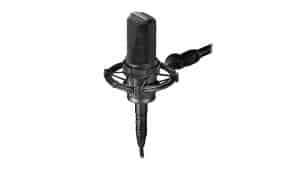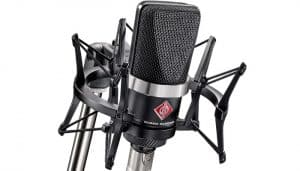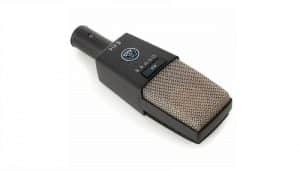The 3 Best Studio Microphones
The recording studio is where a sound engineer loves to be. The great combinations of nuances, audios and voices that we all enjoy in a song continuously occur in these rooms. In studios around the world, a tool stands as the central and essential component of this rich process of making music. Right after the instruments and the musicians who play them what you need are the best studio microphones. And in almost every professional studio, we have roughly the same cast of characters to deliver these exciting art performances.
- Comparison Chart of the 3 Best Studio Microphones
- 1.- Audio-Technica AT2050 Studio Microphones
- Buying Guide For the Audio-Technica AT2050 Studio Microphones
- 2.- Neumann TLM 102 Studio Microphones
- Buying Guide For the Neumann TLM 102 Studio Microphones
- 3.- AKG Pro Audio C414 XLS Studio Microphones
- Buying Guide For the AKG Pro Audio C414 XLS Studio Microphones
- Why Buy Studio Microphones?
- Important points that I should know before buying studio microphones of any brand or model
- What Is Needed For A Home Studio?
- Which Studio Microphone Should I Buy?
- Conclusion
- Comparison Chart of the 3 Best Studio Microphones
Comparison Chart of the 3 Best Studio Microphones
1.- Audio-Technica AT2050 Studio Microphones

Considered by many retailers as one of its top selling brands, the Audio Technica AT2050 is a professional studio microphone that features dual large-diaphragm condenser, low-noise transformerless design, and floating construction. These three features complement each other to give this microphone superior sound quality, quiet studio operation, and professional-grade isolation against vibration and noise.
Other notable features include its high maximum SPL of 159 dB, which is remarkably high for a condenser microphone, and its three-way polar pattern selector for added versatility. While primarily used to capture the human voice, the AT2050 is a studio microphone that can be used in almost any type of instrument and sound source.
Many users say that the microphone has a very neutral and clear sound; some even say that it is the most honest of the microphones that they have tried in the same price range. Others also appreciate the warmth of the AT2050, reporting that it works well with different vocal styles. Sound engineers have reported that they have found a lot of good uses for it, and have said that it is an excellent microphone for studios because it can be used to capture a wide variety of instruments.
Although many prefer transparency, there are those who prefer subtle coloring, but that is already everyone's preference. The AT2050 has its own low noise and can handle a sound pressure above 130 dB and still deliver quality sound. It offers crystal clear highs, rich bass and balanced mids, and with Audio Technica's advanced acoustic engineering you'll experience the highest quality and great performance. It's one of those microphones you can use to record virtually an entire album.
From female or male voices to guitars, drums, or even grand pianos, this microphone will bring you a modern, solid and impactful sound. If you're looking for additional features, it has a switchable 80Hz high-pass filter and 10dB attenuation.
Buying Guide For the Audio-Technica AT2050 Studio Microphones
For this price tag you won't find many condenser microphones that will serve you so well on all your sound source recordings. With 3 switchable polar patterns, the AT2050 is a must for all studio owners who want a microphone for many years and purposes.
Price-quality ratio
This is an overall excellent studio microphone. Its price is somewhat expensive, but it is an investment of great durability and great quality.
Highlighting Features
If you want more of a polar pattern for versatility, Audio Technica AT2050 is for you. This large diaphragm condenser microphone offers multiple polar patterns. You can select from Cardioid, Omnidirectional, or Figure 8 to get the best match for any sound source you are recording.
Technical specifications
Where to Buy the Audio Technica AT2050 Studio Microphones?
If your budget allows it, and you're looking for a reliable, transparent, and versatile dual-diaphragm microphone, the Audio-Technica AT2050 is recommended. We got these studio microphones on Amazon.com
- Tres patrones polares conmutables: omni, cardioide, figura en ocho
- Avanzada electrónica de montaje en superficie que asegura el cumplimiento de los estrictos estándares de consistencia y fiabilidad de Audio-Technica
- Filtro pasa alto de 80 Hz conmutable y pad de 10 dB
- Muy versátil; ideal para voz, percusión, cuerdas, amplificadores y kits de batería
- El diseño de la cápsula de doble diafragma mantiene una precisa definición del patrón polar a lo largo de toda la gama de frecuencias del micrófono. Sus dos grandes diafragmas han sido vaporizados con oro y envejecidos para conseguir las características óptimas durante muchos años de uso.
2.- Neumann TLM 102 Studio Microphones

The TLM102 brings you Neumann's brand of sound quality at a more affordable price, thanks to its relatively smaller profile and streamlined design. Surprisingly, this microphone actually contains a large diaphragm condenser capsule, and features a transformerless condenser, giving you superior clarity like that found in more expensive studio microphones.
To make it wallet friendly, the Neumann TLM 102 comes with a single cardioid pattern with no additional features. This limits its versatility, but makes it easier to work with since there are no settings to play with. It is specially designed for vocal recording with a slight emphasis on mid-range.
Some people are not very happy with its streamlined design, especially considering that there are cheaper ones with more features. Still, most users find the TLM102 well worth it. If budget is no problem and you are looking for a simple and compact vocal microphone to use in your studio, then the Neumann TLM102 is recommended.
A list of the best studio recording microphones that does not include a Neumann model is not a reliable one. This brand is specially known for his “U” model series (U47, U87) found in some of the world's best music studios. However, they are quite expensive for beginner and home use.
Neumann TLM (which also includes the TLM 103 and 107 models) forms a new generation of affordable studio condenser microphones. The TLM 102 has a cardioid polar pattern and even has a large diaphragm, despite the size. The maximum sound pressure of 144 dB is ideal for noisy sources like drums. With its fast transient response, it excels at female vocals and instruments like acoustic guitars.
The TLM 102 is a high-end vocal microphone that can be used to record a wide variety of sound sources with high quality, great fullness, and crisp sound. It has a slight boost above 6 kHz, providing excellent vocal presence in an overall mix. It is also exceptionally compact as it weighs less than 1 Kg.
Buying Guide For the Neumann TLM 102 Studio Microphones
If you can afford the Neumann TLM 102, then buy it without hesitation. A professional-looking microphone is sure to perform amazingly well in home recording studios. If you think this is expensive, check out the other Neumann models to compare and you will have a clearer picture about its affordability. The TLM 102 is available in black and a nickel finish for you to choose from and the package includes a shock mount to start recording right away.
Price-quality ratio
For the quality of this product, and compared to other Neumann microphones, this microphone is really affordable.
Highlighting Features
The Neumann TLM 102 continues to exceed the expectations of many, from home studio owners to professionals with large recording studios. You’ll be getting a great microphone both for its solid construction and for its sonic clarity. Some experienced people even consider it the best way to enter the world of high-end microphones. Its compact size is also a great advantage. The TLM102 incorporates everything you'd expect from a Neumann large-diaphragm studio microphone, at a mid-range price.
Technical specifications
Where to Buy the Neumann TLM 102 Studio Microphones?
We got these Studio Microphones Neumann TLM 102 from Amazon.com
- Micrófonos de estudio.
- Neumann.
- 4006087086261.
3.- AKG Pro Audio C414 XLS Studio Microphones

For those who are not delighted with the previous selections, the AKG Pro Audio C414 XLS is the most demanding. It's such an active global microphone that it has been released and reissued over the years since 1971. The C414 is a large diaphragm multi-pattern condenser microphone with which you can switch between 9 directional patterns. Cardioid, wide cardioid, hypercardioid, omnidirectional, figure 8 and 4 other intermediate positions. There is no doubt that the AKG Pro Audio C414 XLS is the most versatile microphone that can adapt to almost any situation.
The AKG C414 features a switchable bass cut filter at 40, 80, and 160Hz to reduce wind noise, subsonic noise, or proximity effect. Also, 3 attenuation pads for gain statization at 0, -6, -12 and -18 dB. It also has a dynamic range of 158 dB. The overall sound quality is excellent, clear and true, without "heat" like tube microphones.
Buying Guide For the AKG Pro Audio C414 XLS Studio Microphones
The AKG C414 is for those who want a working microphone capable of handling everything rather than a couple of different microphones in their studio. Five different pickup patterns and nine in total make it fun to experiment with. It comes in a package with a carrying case.
Price-quality ratio
This microphone offers a great value for the price. It’s a very good microphone at an acceptable price.
Highlighting Features
Its 9 patterns of direction allow some freedom and versatility that is not always achieved with studio microphones.
Technical specifications
Where to Buy the AKG Pro Audio C414 XLS Studio Microphones?
We got these AKG Pro Audio C414 XLS Studio Microphones from Amazon.com
amazon box="B003GUV1FE" template="horizontal" button_detail="https://amzn.to/3bW1F2H" Button_detail_text="SEE MORE DETAILS"]
Why Buy Studio Microphones?
Studio microphones have certain characteristics that every audio engineer cries out for. A good studio microphone should capture sounds as clearly and transparently as possible, in order to have a more accurate representation of the sound in the control console. Although many people prefer microphones that give some brightness, or enhance nuances, actually the clearer and more transparent your sound is, the more you can play and experience the sound.
A good studio microphone should also be able to record or capture ambient sound when required. For this, it must be designed with multiple polar patterns, that you can choose depending on whether or not you want to capture the environment. The studio microphone should ensure you capture the best sound details and nuances hard to be captured with a field microphone. For this, it is most recommended that it be a condenser one.
Important points that I should know before buying studio microphones of any brand or model
As you will see, a good studio microphone makes a difference when it comes to recordings. Keep reading to see more ideal features so you can make a purchase knowing more technical details.
Diaphragm type
Condenser microphones continue to be a staple for studio recording, but don't cut out dynamic microphones just yet because even professionals choose to use them for certain scenarios. While limits can be blurred from time to time, the general idea is that condenser microphones capture more sound detail at the cost of limited sound pressure management, while dynamic microphones can handle higher sources and have better noise rejection.
The safest and most versatile of the two would be the condenser, but if you like to record noisy sound sources or full-band performances, then getting dynamic is the best option. Please note that condenser microphones generally require phantom power or their own power supply to function, while dynamic microphones do not require any type of microphone preamplifier or power supply.
Polar pattern
Polar patterns describe how a microphone captures sound, to be more specific, the location and direction of sound relative to the position of the microphone. Cardioid, with its front capture and rear rejection, is the most widely used for vocal recording. Other patterns such as Figure 8 and Omnidirectional allow more ambient sound to be captured and can also be used to record a group of singers or multiple sound sources.
Frequent response
This specification indicates the intensity with which a microphone responds to various frequencies, which is usually shown in the form of a graph to show the specific frequencies that are emphasized and not emphasized. The resulting sound should ideally be as neutral and flat as possible; however there are those who prefer subtle coloration like extra warmth and low end.
Singers with a low-pitched voice will appreciate those with strong frequencies below 200Hz, as they can better reproduce the tone of their voice. On the other hand, you'll want one that can master some of the highs if your voice tends to be naturally high-pitched. The more familiar you are with the voice you are recording, the more useful the frequency graphs will be for you, and this is why professional studios have multiple microphones to accommodate various types of voice.
Pop filter
Pop filters are essentially "wind screens" that stop excessive air movement and allow sound to pass through. Sudden air movements from loud “p” pronunciations can cause unwanted volume jumps or, worse, cause clipping of the signal, which is not necessary in a recording setup. Many microphones come with combo pop filters, but some have expressed concern about the quality of some of these filters. The more expensive condenser microphones have pop filters built into the case itself for convenient noise protection.
SPL and Attenuation
This indicates the maximum volume, measured in decibels (dB), to which a microphone can be exposed before it begins to distort the signal. This is not a primary concern for vocal recording, but if you want a microphone that you can use for stronger instruments like drums and amps, you'll want to consider those with high SPL.
The microphones mentioned in this guide feature interchangeable attenuation pads, which allow them to handle louder sound sources without distorting the sound. In line with this, an SPL meter is a good tool to have, even for home studios. You can download an SPL meter app for your smartphone or buy a hardware SPL meter for more accurate measurements.
Ghost Power Source
Nowadays, most audio interfaces, mic preamps, and studio mixers offer phantom power, but in case you have an old one that doesn't need a separate mic preamp, you should have a connection that can supply power to the condenser microphones. Please note that there are some condenser microphones that cannot run on phantom power, but instead have a dedicated power supply to power them with the power they need, which is usually the case with tube powered microphones. Dynamic microphones don't require any kind of power, so you don't have to worry about them.
Microphone Versatility
While the main focus of this guide is voice recording, the microphones listed here also work well with other instruments. Dynamic microphones with their maximum high SPL generally work well with strong instruments such as drums and speakers, while condenser microphones also record acoustic guitar and other acoustic instruments. One idea is to consider other instruments that you will also record and get vocal microphones that will also work with them to get more of the money that you are paying.
What Is Needed For A Home Studio?
Which Studio Microphone Should I Buy?
If you are looking for quality, you can choose any of the three from our selection. These are excellent microphones, very durable and of a very high standard. But if we need to further refine our selection, our first recommended will be the Audio Technica AT2050. It is the most complete of the 3.
Remember that the decision to choose a microphone, as technical and objective as you want it to be, always has some subjectivity. And it may seem to you that one of the other two has better characteristics. That’s valid. Try and use the one that suits you best in terms of the features you are looking for and that are ideal for your available budget.
Conclusion
Most microphones have a universal ability to ideally capture and reproduce the audio signal. These are some near perfect studio microphones that will sit in any recording studio. From vocal microphones to those perfect for instrument recordings, these microphones will meet your needs successfully. Our options above are a limited option to make the selection process as comfortable as possible. It is up to you to decide what features and specifications you want and find the perfect one for your needs.
We hope you found this article informative and that it has helped you choose the right studio microphone for your recordings. Good luck with your purchase.
Comparison Chart of the 3 Best Studio Microphones
Última actualización el 2024-07-26 / Enlaces de afiliados / Imágenes de la API para Afiliados
Si quieres conocer otros artículos parecidos a The 3 Best Studio Microphones puedes visitar la categoría Types.
Leave a Reply




¡Más Contenido!